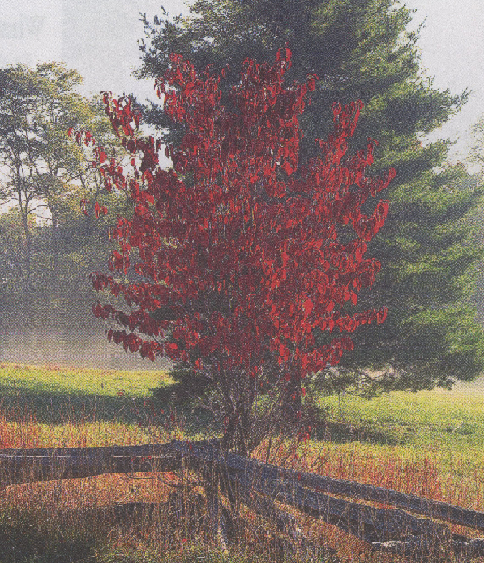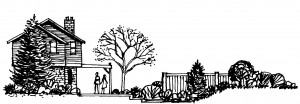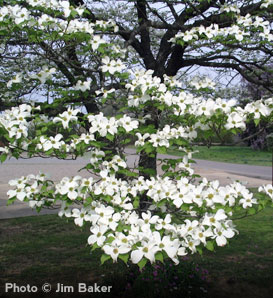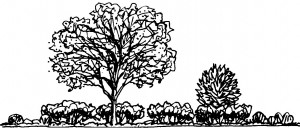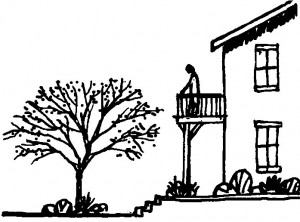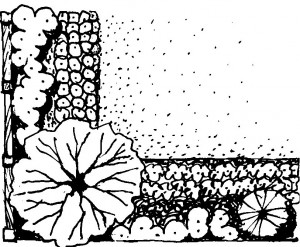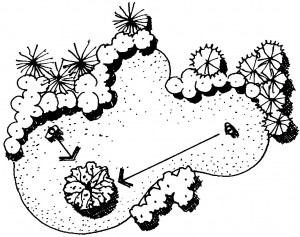Now live: The 2025 Canopy Report. Learn how Americans see trees. GET THE REPORT
Writer-naturalist Donald Peattie once wrote, "Lovely as it is, dogwood stoops also to be useful."
What's in a Name?
For all the beauty of this tree, the common name of dogwood may come from something less lovely - "dagger." This, in turn, may actually come from its early use as a skewer, or thin piece of wood used to hold meat together. The tendency of its wood to not splinter made it popular for this purpose.
The scientific genus name, Cornus, derives from the Latin, cornu, or horn, in reference to another use of its hard wood. The species name, florida, is also from Latin, flos, meaning flowery.
Seasonal Color
The blossoms of dogwood add a welcome touch of color in early spring. If space allows, the white can be accentuated with a background of conifers. Bright autumn foliage and red berries that linger into winter add a bold stroke of color to any landscape design. Outdoor "Room"
In a small, intimate space where an enclosed feeling is desired, the spreading branches of dogwood can provide a pleasant "roof." (Some pruning of the lowest branches might be necessary for this use.) Shade over a deck or patio can also be a good use, and as a bonus the winter berries will attract birds to within viewing range.
How to Plant and Care for Flowering Dogwood
When planting flowering dogwood, careful site selection and some attention to regular care will be rewarded with an addition to the landscape that provides long-lasting, four-season beauty around the home, business or in lightly used areas of parks. Under the best of conditions, the growth rate of this tree is considered "medium."
How to Plant
Best soil is a cool, acidic (pH 5.5 to 6.6) loam with a high percentage of organic matter. However, it can tolerate both heavier soils or lighter, sandy soils if other conditions are right. Be sure to plant with the root collar or top of the root ball level with the soil surface -- not a bit deeper!
Can be planted in shade or partial shade, but full sun helps prevent dogwood anthracnos fungus. Avoid:
- Sites where soil compaction is unavoidable
- Alkaline soil
- Soil that is poorly drained
- Soil that becomes excessively dry in summer
- Sites exposed to salt spray or air pollution problems
- Excessively hot sites such as parking lots
Keeping Your Dogwood Healthy
In recent years, dogwoods have been planted in harsh sites where stress predisposes them to a variety of diseases. In addition to planting only on proper sites, here are some suggestions to keep flowering dogwoods healthy.
- Use 2 to 4 inches of wood chip mulch to help keep the soil cool and moist, and to reduce compaction.
- Extreme care is necessary to prevent trunk damage such as from construction, lawn mowers or weed cutters. Wounds predispose this species this species to invastion by dogwood borers.
- Water during prolonged dry spells, but to prevent conditions that help spread disease, avoid wetting the leaves with irrigation water. Use a hose, drip irrigation or other systems that can apply water close to the ground.
- Rake and dispose of leaves in autumn to help sanitize the area.
- Dogwood anthracnose is a troubling disease that has become nearly epidemic since the late 1970s. Planting as described above can help prevent this disease. Research has shown that infected trees can be saved by pruning and destroying infected branches. Saws or shears should be sanitized in Clorox or a similar solution after infected trees are pruned.
Landscaping with Flowering Dogwood
Accent Tree: Sometimes a specimen tree (see below) can be placed effectively among a mass of lesser plant material. In this usage it is called an accent tree. It becomes a focal point for viewing and adds to the beauty of the entire ensemble of plants. Planting in this way also protects dogwood's compaction-sensitive roots.
Viewed from Above: Branching structure and the delightful way blossoms are borne upward on the branches make this a good choice to plant beneath balconies, high porches, and room windows that look downward on the landscape.
Pivot Point: Dogwood is a visually pleasing tree to use at a point where two linear flower or ground cover beds form a right angle.
Specimen Tree: A specimen tree is a free-standing element in a landscape design. Picturesque ornamentals are selected for this role - standing alone like a piece of fine sculpture to be viewed from all sides. In small spaces where there is little foot traffic or where a mulch bed can prevent soil compaction, a dogwood tree can serve this purpose.
